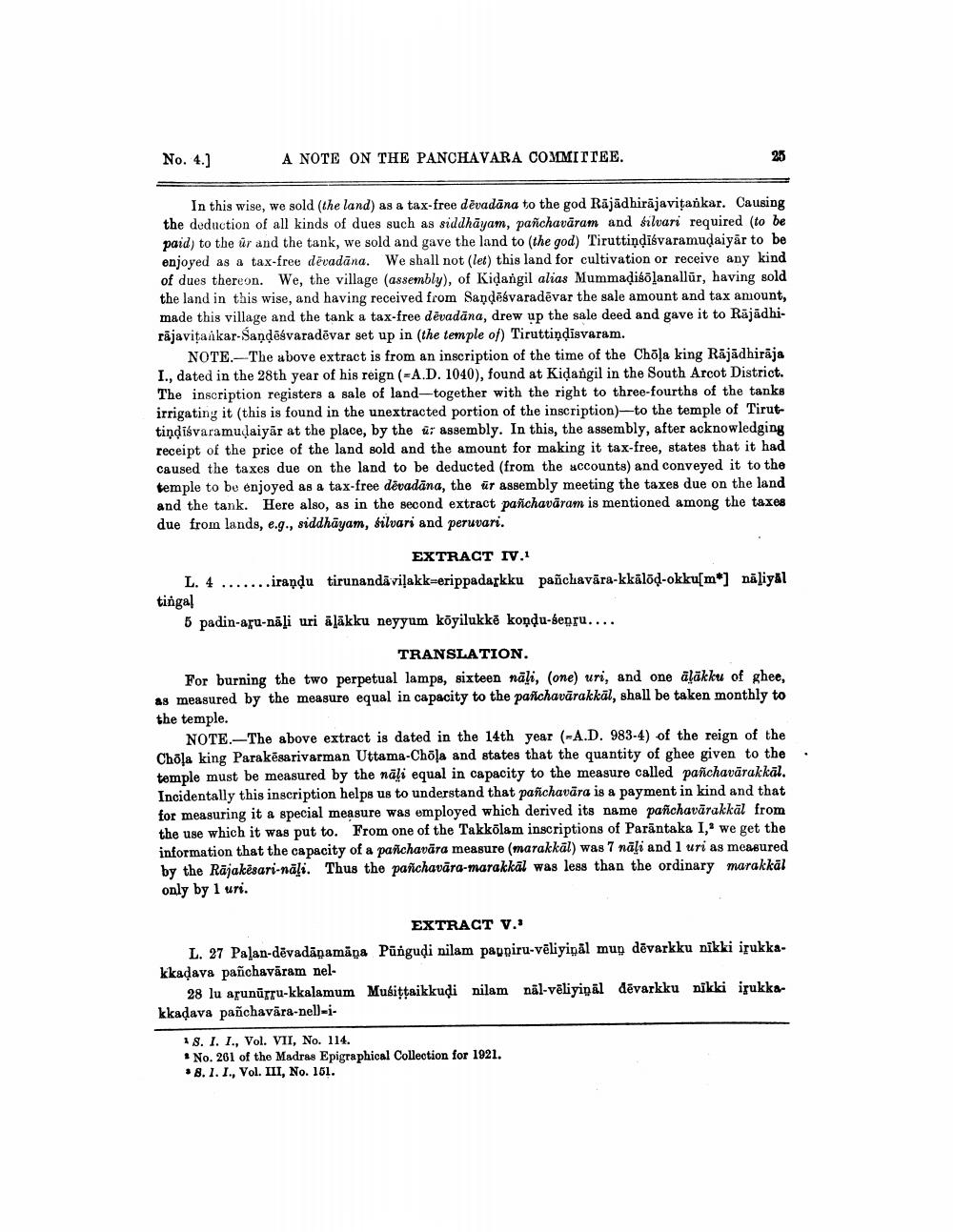________________
No. 4.)
A NOTE ON THE PANCHAVARA COMMITTEE.
In this wise, we sold (the land) as a tax-free dēvadāna to the god Rājādhirajavițankar. Causing the deduction of all kinds of dues such as siddhāyam, pañchavāram and silvari required (to be paid) to the ur and the tank, we sold and gave the land to the god) Tiruttiņdīśvaramudaiyar to be enjoyed as a tax-free dévadāna. We shall not (let) this land for cultivation or receive any kind of dues thereon. We, the village (assembly), of Kidangil alias Mummadisolanallur, having sold the land in this wise, and having received from Saņdēsvaradevar the sale amount and tax amount, made this village and the tank a tax-free dēvadāna, drew up the sale deed and gave it to Rājādhiräjavitaikar-Sandēsvaradēvar set up in the temple of) Tiruttiņdisvaram.
NOTE.-The above extract is from an inscription of the time of the Chola king Rājādhirāja I., dated in the 28th year of his reign (-A.D. 1040), found at Kidangil in the South Arcot District. The inscription registers a sale of land-together with the right to three-fourths of the tanks irrigating it (this is found in the unextracted portion of the inscription to the temple of Tiruttindiśvaramudaiyar at the place, by the u assembly. In this, the assembly, after acknowledging receipt of the price of the land sold and the amount for making it tax-free, states that it had caused the taxes due on the land to be deducted (from the accounts) and conveyed it to the temple to be enjoyed as a tax-free dēvadāna, the ur assembly meeting the taxes due on the land and the tank. Here also, as in the second extract pañchavāram is mentioned among the taxes due from lands, e.g., siddhāyam, silvari and peruvari.
EXTRACT IV. L. 4 .......iraņdu tirunandāviļakk-erippadakku pañchavāra-kkālod-okku[m*] nāļiyal tinga!
6 padin-aru-näli uri älākku neyyum köyilukke kondu-sepru....
TRANSLATION. For burning the two perpetual lamps, sixteen näli, (one) uri, and one āļākku of ghee, as measured by the measure equal in capacity to the pastchavārakkāl, shall be taken monthly to the temple.
NOTE.The above extract is dated in the 14th year (-A.D. 983-4) of the reign of the Chöļa king Parakēsarivarman Uttama-Chöļa and states that the quantity of ghee given to the temple must be measured by the näli equal in capacity to the measure called pañchavārakkāl. Incidentally this inscription helps us to understand that pañchavāra is a payment in kind and that for measuring it a special measure was employed which derived its name pañchavārakkāl from the use which it was put to. From one of the Takkõlam inscriptions of Parāntaka I,* we get the information that the capacity of a pañchavāra measure (marakkāl) was 7 nāļi and 1 uri as measured by the Rājakesari-nāli. Thus the panchavāra-marakkāl was less than the ordinary marakkal only by 1 uri.
EXTRACT V. L. 27 Palan-dēvadāpamāna Pungudi nilam pappiru-vēliyiņāl muy dēvarkku nikki irukkakkadava pañchavāram nel
28 lu arunārru-kkalamum Musittaikkudi nilam näl-vēliyināl dēvarkku nikki irukkakkadava pañchavära-nell-j
18. I. I., Vol. VII, No. 114. * No. 261 of the Madras Epigraphical Collection for 1921.
8.1. I., Vol. III, No. 161.




